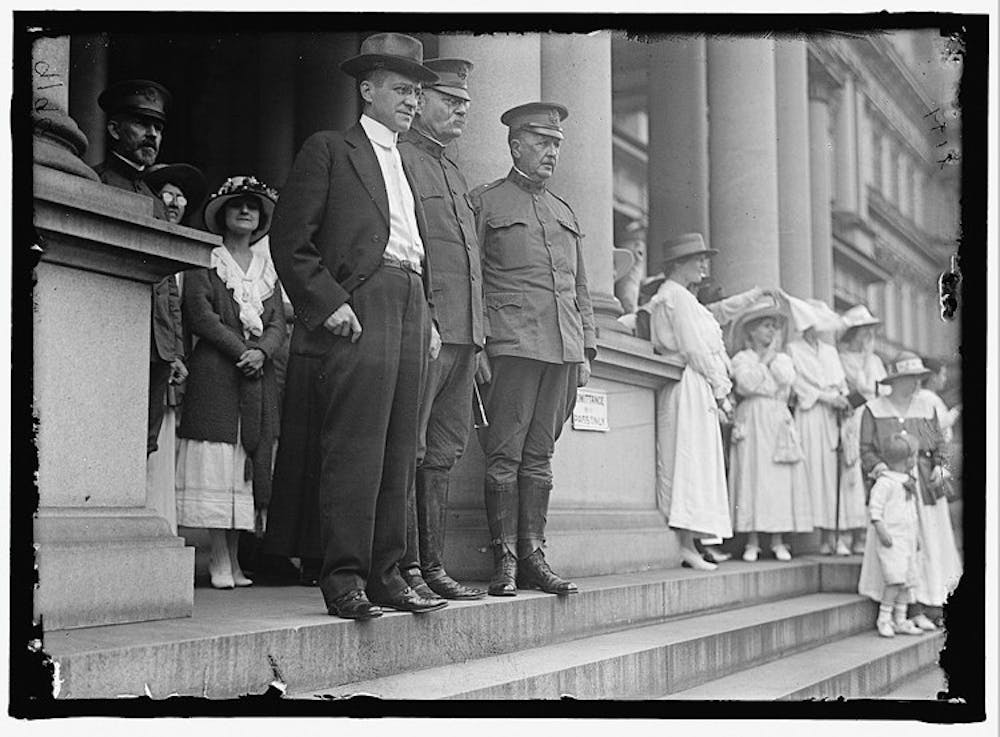Correction Appended
This story is the first in a series investigating World War I-era chemical weapons and equipment buried under AU’s campus and in the Spring Valley neighborhood.
In April 1917, just days after the United States declared war on Germany, AU’s president wrote a letter to the White House.
“To his Excellency, Woodrow Wilson, President of the United States,” AU President Benjamin Leighton wrote. “I am authorized to extend to the United States Government the use of 92 acres of land lying within the District and composing the campus of the University...for such purpose as the Government may desire. The campus may be used either for a camping ground for troops, for gardening and raising products for the Army, or for such other purpose as you may elect.”
The U.S. Secretary of War accepted Leighton’s offer. By that summer, there were 2,100 U.S. Army soldiers and officers stationed and ready for training at “Camp American University,” with thousands more to come.
The new tenants transformed the campus. Before their arrival, the only structures on campus were the College of History, now known as Hurst Hall, and a half-finished McKinley Building.
But over several months, the soldiers’ khaki tents and officers’ wooden barracks filled the quad.
AU’s campus became a small city, with a hospital, horse stable, post office, shoe shop, tailor shop and deli.
The AU newspaper, The Courier, reported the dramatic change of scenery in July 1917.
“The change from a wooded and grass-covered expanse with the white marble fronts of University buildings showing through the green of the trees, to a busy and bustling tent and board city of several thousand soldiers, before whose onslaught every particle of grass has been turned to well-trodden dirt and clay, is startling and incongruous,” the newspaper said.
The U.S. government also built a Young Men’s Christian Association office on campus.
The YMCA provided soldiers and officers with a weekly schedule for religious services and entertainment.
Every Thursday night, the soldiers gathered in the amphitheater ¬— known to them as the “Auditorium in the Grove” — for a stage performance by actors from D.C.
Between 3,000 and 4,000 soldiers and civilians attended these performances every week, according to The Courier.
But the soldiers didn’t spend all their time in the “Auditorium in the Grove.”
Officers regularly sent them on eight-mile practice marches up and down Massachusetts Avenue, which would take hours to complete.
They practiced marching formations and had bayonet practice in the fields on the South side of campus to train for the trench warfare on the battlefields of France.
“The American University is doing its duty, first in peace, now in war,” The Courier wrote in October 1917. “And when peace returns, once more the scholarly duties will replace the martial trappings.”
Although students seemed to welcome the Army at first, they soon worried about the University’s well-being.
“What more can the American University do for the United States Government that it has not done?” The Courier wrote.
While AU provided housing for thousands of soldiers, its academics suffered. University lectures, which were open to the public, were “reduced to a minimum,” the Courier wrote. “Sentinels challenge every person who enters the grounds and buildings; even the officers of the University must show their passes.”
Though the University’s academic research faltered, research on chemical weapons began to thrive on the campus grounds.
See the second part of this series in The Eagle’s March 15 issue.
news@theeagleonline.com
Correction: An earlier headline on this story stated AU volunteered its campus to the Army Corps of Engineers in 1917. AU volunteered its campus to the Army in 1917.





